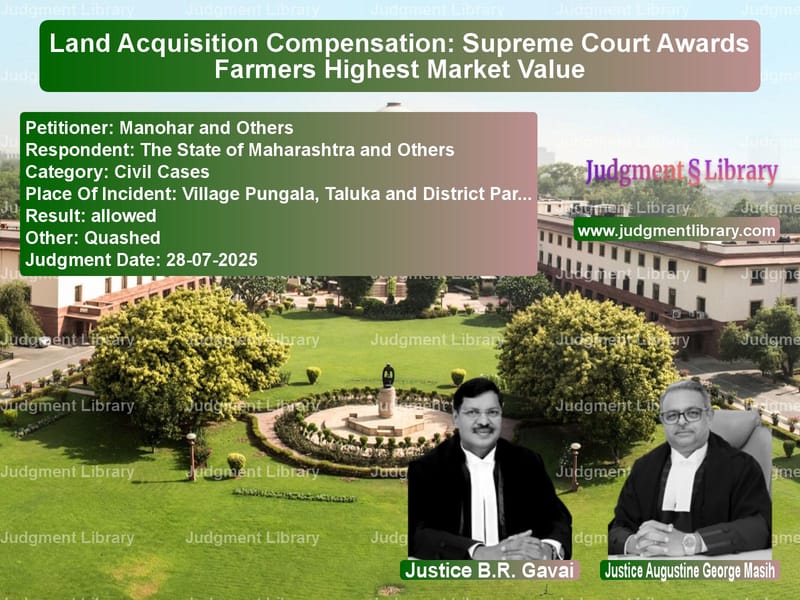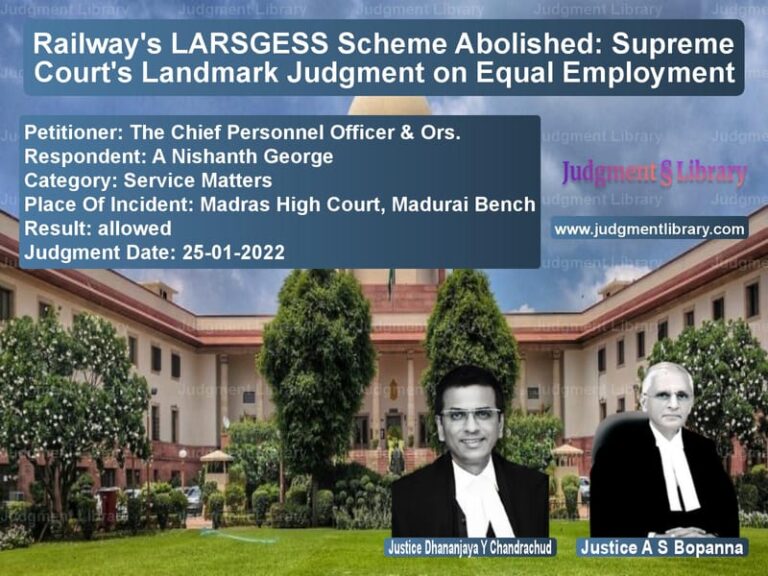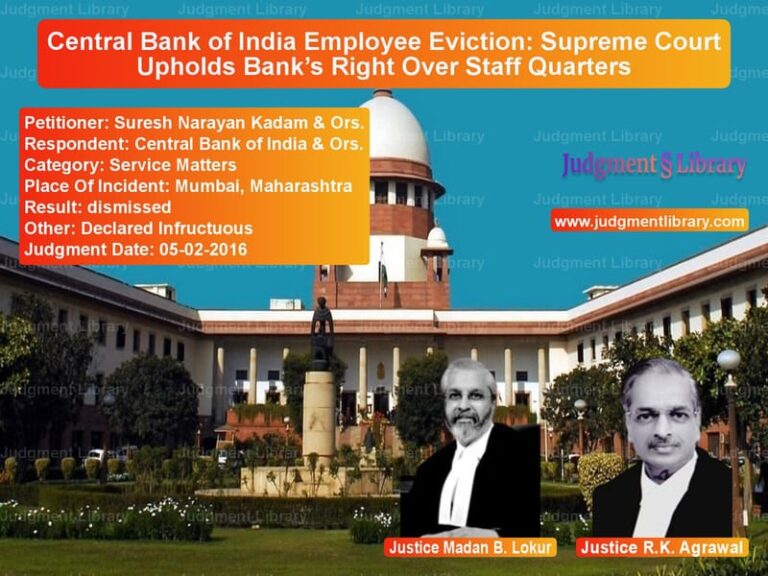Land Acquisition Compensation: Supreme Court Awards Farmers Highest Market Value
For over three decades, a group of farmers from Maharashtra fought a legal battle for fair compensation after their lands were acquired for industrial development. Their struggle finally reached the Supreme Court, where Chief Justice B.R. Gavai delivered a landmark judgment that would redefine how compensation is calculated in land acquisition cases across India.
The story begins in the early 1990s when the Maharashtra Industrial Development Corporation (MIDC) acquired lands from farmers in Village Pungala, located just 2 kilometers from Jintur town in Parbhani District. The acquisition was for setting up an industrial area, and the Land Acquisition Officer awarded compensation of Rs. 10,800 per acre in 1994. The farmers, believing this amount didn’t reflect the true value of their prime land, accepted the compensation under protest and began their legal journey.
Their case traveled through multiple courts over the years. The Reference Court in 2007 enhanced the compensation to Rs. 32,000 per acre, but this still fell short of what the farmers believed was fair. When they approached the High Court, their appeal was dismissed in 2022. Undeterred, they brought their case to the Supreme Court, arguing that the courts below had ignored the most important evidence – the highest sale exemplar that showed their land was worth much more.
The Legal Battle Unfolds
The farmers’ legal team, led by Mr. Adith Satish Deshmukh and Mr. Bharat Thakorlal Manubarwala, presented a compelling case. They argued that the Reference Court had made a critical error by completely overlooking the highest sale exemplar dated 31st March 1990, which showed land selling for Rs. 72,900 per acre. They emphasized that the farmers had lost their only source of sustenance and deserved fair compensation based on the highest bona-fide transaction available.
The lawyers for the farmers made their position clear: “Reference Court and High Court ought to have given benefit of the highest exemplar sale deed to the Appellants.” They pointed out that the courts had already found that the acquired lands were situated in a prime location – near the T-point of Nashik-Nirmal State Highway, adjacent to Jintur town, with a percolation tank just opposite the lands providing sufficient water.
On the other side, the lawyers for the MIDC and State Government presented their arguments. Ms. Shyamali Gadre, representing MIDC, contended that “the Reference Court was justified in not considering the highest exemplar sale deed dated 31st March, 1990, showing market value of Rs. 72,900/- per Acre, as it reflected an unusually high rate.” She argued that the sale exemplars relied upon by the farmers were of small plots in Jintur town, each less than 1 hectare, while the total area under acquisition was 89 hectares and 44 are.
The Supreme Court’s Analysis
The Supreme Court conducted a thorough examination of the case records and found that both lower courts had committed significant errors. The Court noted that the Reference Court, after carefully analyzing all ten sale exemplars and finding them to be bona-fide transactions, surprisingly ignored the highest one without any explanation.
Justice Gavai’s bench made a crucial observation: “It can thus be seen that though the High Court recorded, in paragraph 49, that the Reference Court considered in all ten exemplars and that it did not consider the sale instance at Sr. No. 4 dated 31st March 1990… in the immediate next paragraph i.e., paragraph 50, the High Court takes a diametrically opposite view.” This inconsistency in the High Court’s reasoning became a pivotal point in the Supreme Court’s decision.
The Court emphasized the settled legal position regarding compensation calculation, drawing from previous landmark judgments. The bench quoted extensively from the case of Anjani Molu Dessai v. State of Goa, where it was established that: “The legal position is that even where there are several exemplars with reference to similar lands, usually the highest of the exemplars, which is a bona fide transaction, will be considered.”
The judgment further elaborated this principle by citing State of Punjab v. Hans Raj: “After all when the land is being compulsorily taken away from a person, he is entitled to say that he should be given the highest value which similar land in the locality is shown to have fetched in a bona fide transaction entered into between a willing purchaser and a willing seller near about the time of the acquisition.”
Rejecting the Government’s Arguments
The Supreme Court systematically addressed each argument put forward by the MIDC. When the government lawyers claimed that the highest exemplar represented an “abnormally high value,” the Court rejected this contention outright. The bench found that the land was indeed situated in a prime location with significant advantages.
The Court noted: “It is not in dispute that the land was acquired for public purpose for the establishment of Jintur Industrial Area. Further, the lands in question are situated at village Pungala, which is at a distance of 2 kilometres from Jintur, a taluka place and where the market committee, Wakhar Mahamandal, dairy business and other basic facilities are available.”
Regarding the government’s argument that the farmers hadn’t proved the sale was bona-fide, the Court invoked Section 51A of the Land Acquisition Act, which states that certified copies of documents can be accepted as evidence of transactions. Since the government had led no rebuttal evidence, this argument also failed.
The Court made a significant observation about the timing of the sale exemplars: “The sale instances at Sr. Nos.1, 2 and 3 are of April/May of 1989 and the notice under Section 32(2) of the Act of 1961 was issued on 19th July 1990, as such, the sale exemplar at Sr. No.4 i.e., the sale instance dated 31st March 1990, is the most proximate to the date of transaction.”
Landmark Legal Principles Established
The Supreme Court’s judgment reinforces several important legal principles that will guide future land acquisition cases across the country. The Court reiterated that when multiple sale exemplars are available, the highest bona-fide transaction should generally be preferred unless there are strong reasons to do otherwise.
The bench quoted from Mehrawal Khewaji Trust v. State of Punjab: “It is clear that when there are several exemplars with reference to similar lands, it is the general rule that the highest of the exemplars, if it is satisfied that it is a bona fide transaction, has to be considered and accepted.”
The Court also clarified when averaging of sale prices is permissible: “only where there are several sales of similar lands whose prices range in a narrow bandwidth, the average thereof can be taken, as representing the market price.” In this case, since the sale prices ranged from Rs. 25,000 to Rs. 72,900 per acre, averaging was not appropriate.
The Final Outcome
After extensive analysis, the Supreme Court allowed the farmers’ appeals and enhanced their compensation substantially. While accepting the highest exemplar of Rs. 72,900 per acre, the Court applied a 20% deduction since the acquired land was much larger than the plots in the sale exemplars. This brought the compensation to Rs. 58,320 per acre – nearly double what the Reference Court had awarded and more than five times the original compensation.
The Court justified the deduction by noting: “The Reference Court, therefore, correctly came to the conclusion that while accepting the sale instances a reasonable reduction requires to be made. As such, the land which is acquired being much larger in area, the Reference Court applied a deduction of 20% in the price determined.”
In its final order, the Supreme Court directed: “We direct that the compensation granted to the Appellants be enhanced from Rs. 32,000/- per Acre to Rs. 58,320/- per Acre; and we further direct that all other consequential benefits of solatium and interest on the enhanced compensation in terms of Section 23(1-A), 23(2) and 28 of the Land Acquisition Act, 1894, be granted to the Appellants.”
A Victory for Farmers’ Rights
This judgment represents a significant victory for land owners across India, particularly farmers whose livelihoods depend on their land. The Supreme Court’s decision sends a clear message that when the government acquires land for public purposes, it must pay fair compensation that reflects the true market value, giving owners the benefit of the highest bona-fide transactions.
The Court’s reasoning acknowledges the fundamental injustice that occurs when people are forced to give up their land without adequate compensation. As the judgment eloquently states: “After all when the land is being compulsorily taken away from a person, he is entitled to say that he should be given the highest value which similar land in the locality is shown to have fetched.”
This case also highlights the importance of proper legal representation and persistence in seeking justice. The farmers fought for over three decades, moving from the Land Acquisition Officer to the Reference Court, then to the High Court, and finally to the Supreme Court. Their perseverance ultimately paid off, setting a precedent that will benefit countless other land owners in similar situations.
The Supreme Court’s judgment not only provides justice to these particular farmers but also strengthens the legal framework protecting property rights in India. It establishes clear guidelines for calculating compensation and ensures that future cases will be decided based on the principle that when the government takes private property, it must pay the highest fair value, not the lowest acceptable amount.
Petitioner Name: Manohar and Others.Respondent Name: The State of Maharashtra and Others.Judgment By: Justice B.R. Gavai, Justice Augustine George Masih.Place Of Incident: Village Pungala, Taluka and District Parbhani, Maharashtra.Judgment Date: 28-07-2025.Result: allowed.
Don’t miss out on the full details! Download the complete judgment in PDF format below and gain valuable insights instantly!
Download Judgment: manohar-and-others-vs-the-state-of-maharas-supreme-court-of-india-judgment-dated-28-07-2025.pdf
Directly Download Judgment: Directly download this Judgment
See all petitions in Property Disputes
See all petitions in Damages and Compensation
See all petitions in Compensation Disputes
See all petitions in Judgment by B R Gavai
See all petitions in Judgment by Augustine George Masih
See all petitions in allowed
See all petitions in Quashed
See all petitions in supreme court of India judgments July 2025
See all petitions in 2025 judgments
See all posts in Civil Cases Category
See all allowed petitions in Civil Cases Category
See all Dismissed petitions in Civil Cases Category
See all partially allowed petitions in Civil Cases Category







